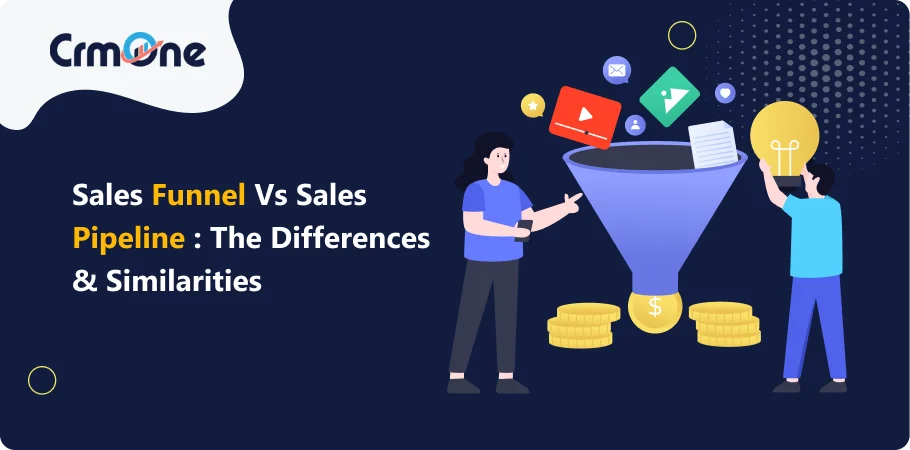In the bustling world of sales and marketing teams, understanding your sales process is key to success. Whether you’re nurturing new leads or trying to close deals, how you manage this process can make all the difference. That’s where concepts like the sales funnel and sales pipeline come into play. Though they may sound similar, each plays a unique role in how businesses track and manage sales activities.
This blog explores the sales funnel and sales pipeline. We’ll explore each concept thoroughly, highlight how they differ, and examine where they overlap. By comparing these strategies side-by-side, we aim to show you how effective sales pipeline management can boost your overall sales strategy.
Join us as we break down these key elements of sales management in a way that’s easy to understand. Whether you’re a seasoned pro looking to refine your strategy or new to the field and setting up your processes, this guide will help you determine which focus—funnel, pipeline, or both—is best for your business’s success.
A sales funnel is a tool that helps businesses understand and guide their prospective customers through the buying process, from their first interaction to making a purchase. It’s like a map showing a customer’s journey with your company.
The Stages of a Sales Funnel
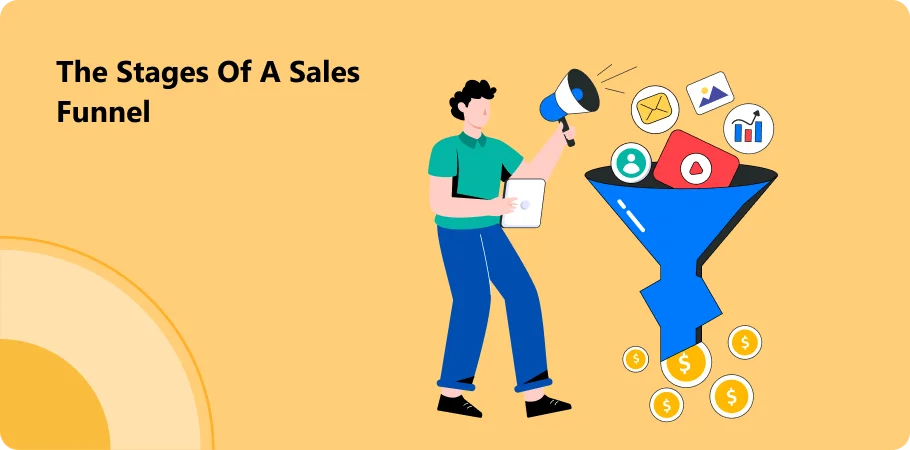
The sales funnel has four main stages, each important in turning a newcomer into a buyer:
Awareness:
This is the start of the journey, where potential customers first learn about your product or service. Your marketing efforts and lead generation efforts play a huge role here, grabbing attention through various channels like social media, ads, or word of mouth.
Interest:
Once you have their attention, the next step is to keep them interested. Here, it would help if you made them see your product as something they want. To build their interest, you provide more information, possibly through emails, sales meetings, or targeted content.
Decision:
At this stage, potential customers are considering buying your product. They might compare your offer with others or consider the price and benefits. Your job is to make your product stand out as the best option. This might involve offering special deals or showing the value of your product over competitors.
Action:
This is the final stage, where your leads become buyers by purchasing. Your efforts here focus on making the buying process as easy and appealing as possible, ensuring the deal is closed smoothly.
How the Sales Funnel Helps
The sales funnel offers a broad view of how marketing efforts and sales meetings help move a person from one stage to the next. It shows:
- How many qualified leads are progressing through each stage?
- How much revenue is being made at each stage?
- The effectiveness of different marketing strategies in moving leads along the funnel.
This broad perspective helps businesses understand where they need to improve. For instance, if many people are stuck at the Interest stage, the company might need to beef up its information delivery or engagement tactics. This way, the sales funnel helps in tweaking marketing efforts to better align with customers’ needs at different stages of their journey.
Additionally, understanding the sales funnel can aid in customer retention. By analyzing existing customers’ journeys, companies can find new ways to keep them engaged and happy. This ensures their return in the future.
In summary, a sales funnel is about more than just revenue generated. It’s a holistic approach that helps businesses strategize their marketing and sales efforts, ensuring no potential customer is lost.
Exploring the Sales Pipeline
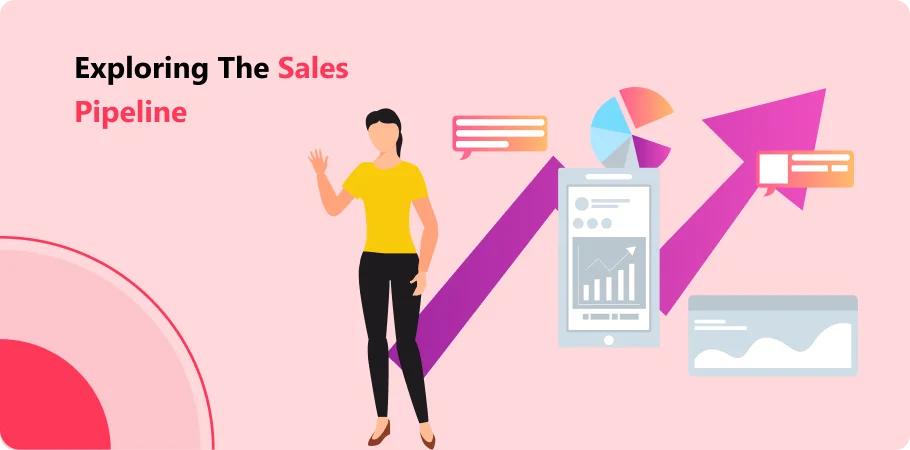
A sales pipeline is a visual and systematic way to track all the steps a sales team takes to close deals. It’s like a detailed roadmap of your entire sales process. Furthermore, it shows potential customers moving from being leads to actual buyers.
Stages of a Sales Pipeline
Here are the common sales pipeline stages that most businesses use to manage their sales activities:
Lead Generation:
This is where everything begins. The marketing team and sales staff work together to attract website visitors and turn them into leads. This could be through online ads, social media, or attending events.
Qualification:
Not all leads are ready to buy. During this stage, salespeople evaluate whether the leads have the potential to become customers. This involves checking if they have the budget, need, and authority to purchase.
Proposal:
Once a lead is qualified, the next step is to propose an offer. This is where you tell them about your product or service and how it can solve their problem.
Closing:
This is the final stage, where negotiations happen and deals are signed. The goal here is to convert the lead into a paying customer.
Post-Sale:
After closing a deal, follow-up is crucial to ensure customer satisfaction and to lay the groundwork for future sales.
Importance of the Sales Pipeline
Direct Interactions:
The sales pipeline focuses heavily on the direct interactions between the sales team and the potential customer. Each stage involves specific actions by the sales team to move the deal forward.
Progress Tracking:
It allows sales leaders to track the progress of every sales opportunity through different stages. This helps in understanding what works and what doesn’t.
Sales Pipeline Reports:
These reports are crucial for analyzing performance. They help you understand conversion rates and where potential sales are getting stuck.
Why is the Sales Pipeline Important?
It gives a clear and actionable view of your sales activities. Knowing where each potential customer is helps the sales team focus their efforts more effectively. It also allows leaders to forecast sales and revenues more accurately.
In summary, the sales pipeline is critical in managing sales processes effectively. It’s more than just the step-by-step journey of making a sale. It also helps refine strategies to enhance performance and achieve better results.
Sales Funnel vs Sales Pipeline
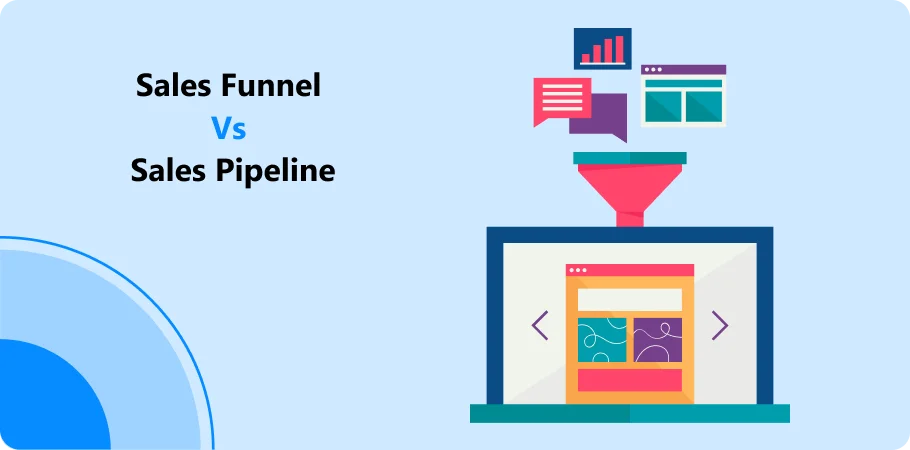
When managing sales, it’s crucial to understand the tools available to you. The sales funnel and sales pipeline are tools, but they serve different purposes and provide other insights into the sales process.
Definitions and Roles
Sales Funnel:
This model shows a potential customer’s journey from learning about your product to purchasing. It tracks how many potential paying customers move through stages like awareness, interest, decision, and action.
Sales Pipeline:
This is more focused on the specific actions and stages of the sales process that the sales team controls. It tracks the progress of qualifying leads, proposals, negotiations, and closing deals. It’s all about the direct interactions that move a prospect to the next stage in the sales cycle.
Key Differences
Volume vs. Stage-Focus:
The sales funnel is about the volume of leads at each stage and how they decrease as they move closer to becoming customers. The sales pipeline, however, is more about the specific stages and the actions required to move leads through them.
Customer Journey vs. Sales Actions:
The funnel provides a holistic view of the customer’s journey and is oriented towards understanding and improving conversion rates through marketing efforts. The pipeline provides a detailed breakdown of sales actions, focusing on lead qualification, scheduling sales meetings, and managing expected close dates.
Metrics:
In a funnel, metrics focus on how many leads move from one stage to the next and the overall efficiency of the marketing campaigns. In a pipeline, the metrics are more about the duration of the year’s sales cycle, accurate sales forecast, and the sales team’s efficiency in moving deals from one phase to another.
Visual Comparison
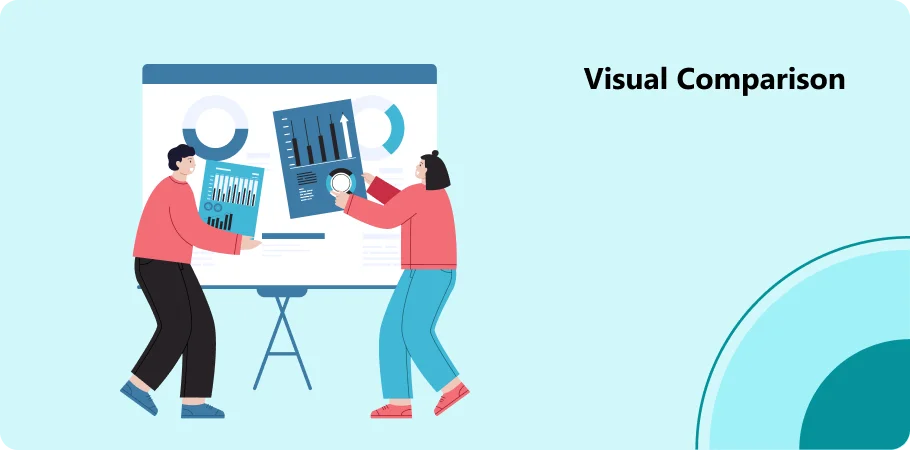
Imagine two diagrams:
- Sales Funnel Diagram: Shaped like an inverted pyramid, showing large numbers at the top (Awareness) and narrowing down as prospects move towards becoming customers.
- Sales Pipeline Chart: This chart looks like a horizontal bar with several compartments, each representing a stage of the sales process (Lead, Qualifier, Proposal, Close). Each compartment has details on the actions and statuses of leads.
Integration of Both
Understanding both a sales pipeline and a sales funnel can provide comprehensive insights into how to attract, manage, and convert leads into customers. While the funnel helps retain customers and understand market behavior, the pipeline clarifies the direct actions needed to manage and close sales effectively. Hence, they ensure a steady flow of revenue.
In summary, while both tools aim to increase sales, the pipeline vs. sales funnel comparison highlights their different focuses: one on the broader customer journey and the other on specific sales activities and stages. Using both effectively can dramatically improve a business’s sales approach.
Interactions and Overlaps
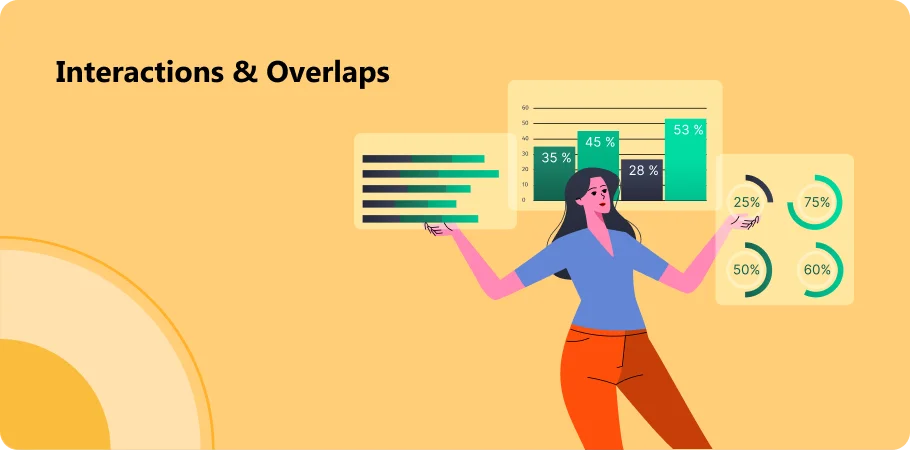
While the sales funnel and sales pipeline might seem different, they work best when used together. Combining these tools can enhance the effectiveness of your sales strategies and improve your overall sales performance.
How the Funnel and Pipeline Work Together
Lead Generation to Lead Qualification:
The sales funnel helps the marketing teams draw in a vast pool of prospective customers. As these leads enter the funnel and show interest, they become part of the sales pipeline, where the sales team starts to qualify leads, determining which ones are ready to move forward in the sales journey.
Conversion Rate Optimization:
The sales funnel report provides insights into where leads drop off, allowing marketing and sales teams to tweak their strategies. This information feeds into the sales pipeline, helping refine the approach at each stage to improve the conversion rate.
Aligning Sales and Marketing Efforts:
The funnel visualizes the initial stages of the buyer’s journey. The sales team must tailor their sales proposals effectively. The sales pipeline report then gives feedback to the marketing team about the quality of leads and the effectiveness of specific marketing campaigns.
Real Business Examples
Software Company Example:
A software company used its sales funnel to track how many free trial downloads converted into paying customers. Analyzing the funnel’s drop-off points, they identified that many users never activated the software after downloading it.
The sales team adjusted their pipeline strategy to include follow-up calls shortly after download, significantly increasing the conversion rate and shortening the expected close date for deals.
Retail Business Example:
A retail business noticed from its sales funnel report that many online customers abandoned shopping carts. It integrated this data into its sales pipeline by initiating a chatbot service that pops up to offer help or a discount to customers who hesitate at the checkout stage. This strategy aligned the marketing efforts with direct sales interventions, boosting conversions.
Book a CrmOne Demo
Experience the CrmOne simplicity and power. Our experts will show you the best ways to use it and answer your questions in real time. See how CRMOne fits your needs.
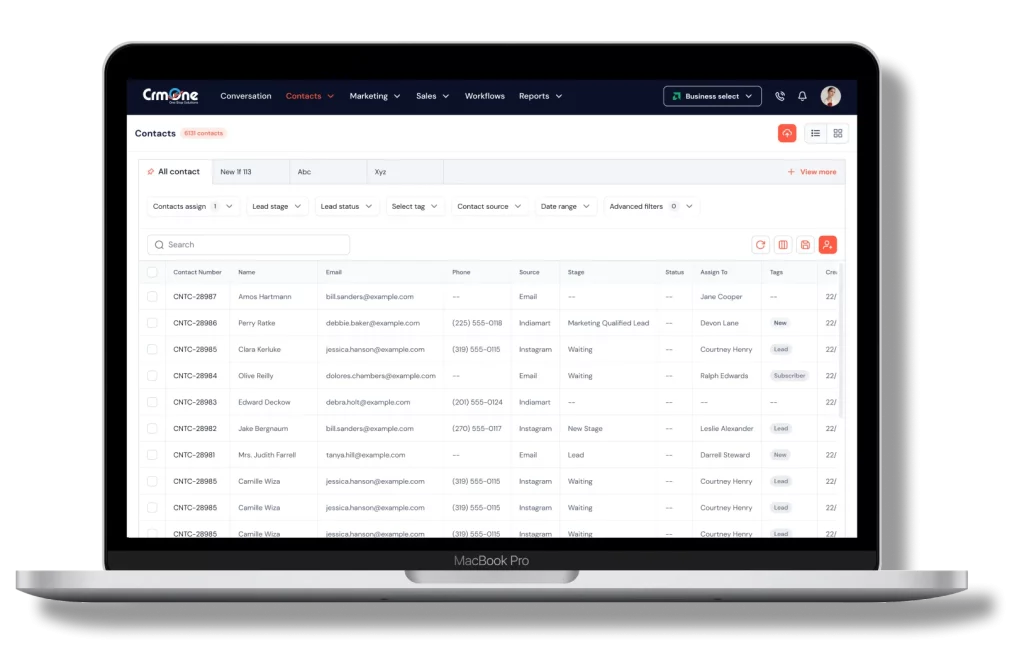
Benefits of Combining Both Models
Customer-Focused:
Using both models helps the business stay customer-focused. While the funnel helps understand the general behavior and preferences of the market, the pipeline provides a clear path to personalizing the approach to individual leads.
Enhanced Forecasting and Planning:
By combining insights from the sales pipeline and sales funnel, companies can more accurately predict future sales and adjust their sales goals and strategies accordingly.
Streamlined Communication:
When marketing and sales teams use both tools in tandem, communication between them improves, leading to more effective marketing campaigns and a more efficient sales process.
Integrating the sales funnel and sales pipeline allows businesses to optimize every stage of the customer journey and sales process, leading to better lead management, higher conversion rates, and more successful sales outcomes.
Which Should You Focus On: Sales Funnel or Sales Pipeline?
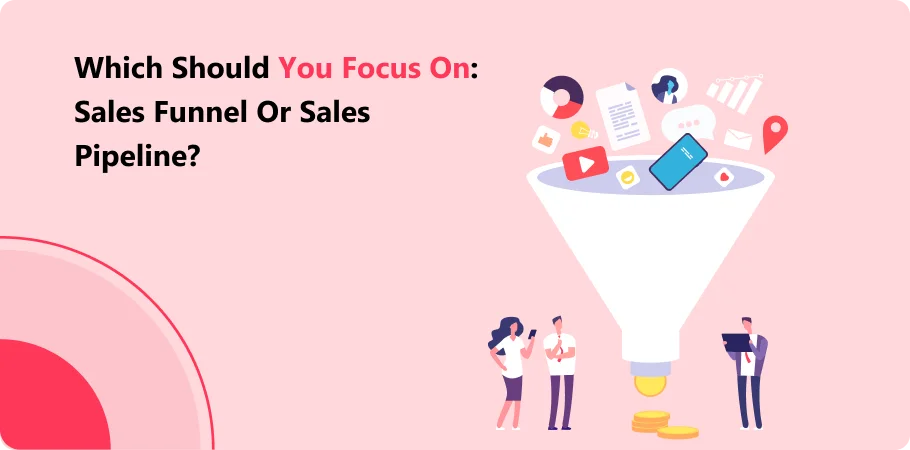
Deciding whether to focus on the sales funnel or the sales pipeline can significantly affect how you manage and convert your sales leads. The choice depends on your business’s specific needs, such as the size of your company, the nature of your product or service, and your sales team’s structure.
Factors to Consider
Size of the Company:
- Smaller businesses with fewer sales reps should focus on the sales funnel. This will help them understand the buyer’s journey and develop effective marketing strategies.
- Larger organizations with more complex sales structures might need to focus more on the sales pipeline to manage detailed pipeline stages and individual sales activities.
Nature of the Product/Service:
- If you’re selling a straightforward product or service, the sales pipeline might be more beneficial for monitoring direct sales activities and pipeline stages.
- For more complex or high-value products, focusing on the sales funnel could help understand the longer and more nuanced buyer’s journey.
Sales Team Structure:
- If you have a specialized team where marketing pipeline activities are separated from sales, the sales pipeline could be more crucial to focus on for those directly involved in closing deals.
- Conversely, a more integrated team might benefit from focusing on the sales funnels to align marketing and sales strategies.
Potential Outcomes and Benefits
Broader Market Insights:
Concentrating on the sales funnel provides a wider view of how prospective customers interact with your marketing efforts. This can be crucial for improving lead generation and marketing strategies.
Enhanced Customer Understanding:
Helps in better understanding the needs and behaviors of potential customers throughout the buyer’s journey.
Focusing on the Sales Pipeline:
Increased Sales Efficiency:
Concentrating on the sales pipeline allows sales teams to manage and track the progress of individual deals more effectively. This leads to higher conversion rates.
Better Resource Allocation:
Sales managers can allocate resources more efficiently, focusing on the most promising leads and pipeline stages that need more attention.
Making the Choice
Sales Funnel for Marketing Focus:
Focusing on the sales funnel makes sense if your primary goal is to improve your ability to attract and nurture leads. It helps ensure that your marketing pipeline effectively feeds suitable leads into your sales process.
Sales Pipeline for Sales Focus:
The sales pipeline is more suitable if the main concern is converting existing leads into sales. This helps sales professionals and reps stay organized and prioritize their efforts to close more deals efficiently.
Ultimately, while the sales funnels and pipelines are essential, your focus should align with your current business objectives and operational needs. Most successful businesses find that a balanced approach, where both the funnel and pipeline are monitored and optimized, leads to the best results in managing and converting sales leads.
Conclusion
Throughout this discussion, we’ve explored the significant roles that sales funnels and pipelines play in managing and understanding sales opportunities. We learned that the sales funnel represents the customer’s overall journey from awareness to purchase, providing broad insights into marketing effectiveness and customer behavior. On the other hand, the sales pipeline represents the specific steps and strategies your sales team uses to close deals, from the initial sales meeting to the final sales proposal.
Whether to focus more on the pipeline or the sales funnel depends mainly on your business’s unique needs. If you aim to optimize how you attract and engage prospective customers, delving deeper into the sales funnel might yield the best results. This approach will help refine how your product or service is presented and perceived in the early stages of customer interaction.
Get started for Free
Start for free today. Boost your sales by clicking the Get Started button. With CRMOne, you can manage leads, sales, and customer service all in one place.
